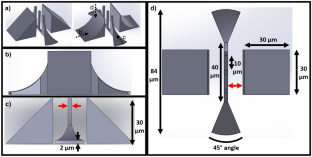High-aspect-ratio three-dimensional polymer and metallic microstructure microfabrication using two-photon polymerization
Abstract
Creating micrometer-resolution high-aspect-ratio three-dimensional (3D) structures remain very challenging despite significant microfabrication methods developed for microelectromechanical systems (MEMS). This is especially the case when such structures are desired to be metallic to support electronic applications. Here, we present a microfabrication process that combines two-photon-polymerization (2PP) printing to create a polymeric high-aspect-ratio three-dimensional structure and electroless metal plating that selectively electroplates only the polymeric structure to create high-aspect-ratio 3D metallic structures having micrometer-resolution. To enable this, the effect of various 2PP processing parameters on SU-8 photoresist microstructures were first systematically studied. These parameters include laser power, slicing/hatching distances, and pre-/post-baking temperature. This optimization resulted in a maximum aspect ratio (height to width) of ~ 12. Following this polymeric structure printing, electroless plating using Tollens’ Reagent were utilized to selectively coat silver particles only on the polymeric structure, but not on the silicon substrate. The final 3D metallic structures were evaluated in terms of their resistivity, reproducibly showing resistivity of ~ 10–6 [Ω·m]. The developed 3D metallic structure microfabrication process can be further integrated with conventional 2D lithography to achieve even more complex structures. The developed method overcomes the limitations of current MEMS fabrication processes, allowing a variety of previously impossible metallic microstructures to be created.


 求助内容:
求助内容: 应助结果提醒方式:
应助结果提醒方式:


